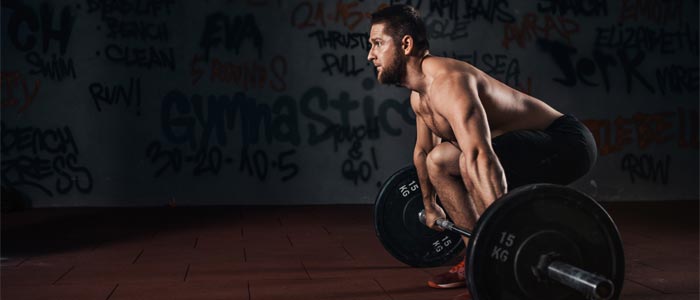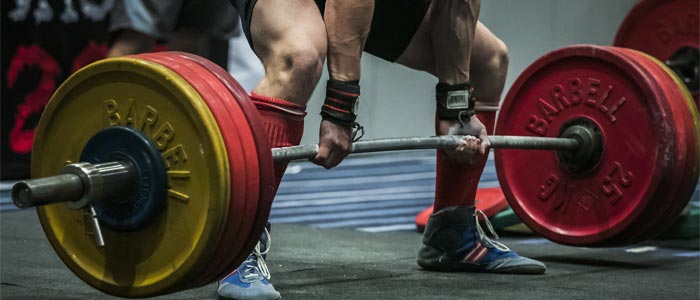How To Master The Art Of The Deadlift
10th Jan 20

The deadlift is one of the most effective and actually functional exercises that you can do in your training. No one can really argue it. It is fundamental when it comes to strength training and a crucial part of many people’s exercise routines, for a good reason. You’ll feel the benefit no matter what your exercise goals are.
It utilises a huge range of muscles simultaneously, doing their own thing and creating a general increase in strength, but it is crucial to know what you’re doing and how to up your game.
Whether you’re an avid deadlifter or a complete novice, we’ve put together this awesome guide on how to deadlift to make sure you get it spot on 100% of the time, no matter what (and some cool new ways to try it too). So listen up and brace yourself!
Want to move fast? Jump to the right section below.
Setting Up Your Deadlift
Before you start getting your deadlift on, there are a few things to consider. You need to make sure you’ve got all of these nailed if you want to make the most progress, and it’s all vital to learning how to deadlift better than ever. Take notes.
Feet Positioning
The standard starting point is the feet. Make sure your feet are facing forwards and are around your hip/shoulder-width apart for the safest and best possible technique. This sets you up for a higher chance of success and a lower chance of injury from start to finish. That’s important.
Make sure the bar is over the midpoint of your foot rather than touching your shin or being in front of your toes. Otherwise, you will likely bend too far to pick it up and do lower back damage. (It’s worth noting to stretch it out before you start, too, especially with your back and hamstrings).
When you lower yourself to grab the bar, your shins will touch it, and that’s when you know you’re in the right place. If you can’t get this far down with the bar in the right place, consider placing the bar onto a step or elevating it in another way until you can reach it without this assistance.
Grips
Once your feet are in the right place, it’s onto phase 2: the grip. When you deadlift, you have more options than you may think than just grabbing the bar and flexing. So it’s vital for a start that you choose the right grip.
There’s more to perfecting your deadlift than just learning how to stand, and the direction and distance you apply to your hands make all the difference in what the exercise will do and how it’ll affect your movement.
The most common way to do it, and probably the best for you to learn, is the mixed grip instead of the over or underhand. This means one hand faces in, and one faces out. Experiment with a few when you feel ready, and you’ll see the difference for yourself.
The Deadlift Technique

Moving on to the exercise itself, this is where things get serious. You probably already know deadlifting is all about the technique, and if you don’t know how to do it, you’re at serious risk of an injury and won’t perform at your best.
Balance Mid-Foot
When you begin to lift the bar, it’s important to know that the weight of your entire exercise should be through your heels and midfoot, not your toes. If the front of your foot has the weight, you are likely to be too far forward and using a weight that is too heavy for you to use correctly.
Back Straight
The most important point of this entire exercise is that you keep your back straight throughout. Any curvature of the spine makes it extremely likely for you to cause serious damage to your back in both the long and short term if you are not careful, so make sure this is a focal point throughout. If you need any help with a larger weight, consider a belt too.
Arms Straight
When you get the bar off the ground, your arms should be kept straight. It seems a common mistake to allow your arms to bend slightly at the elbow, which is not a good choice. Your arms should be straight from start to finish, and your shoulders should not be shrugged, either.
Shoulders Forward
Keep your shoulders in front of the bar, and do not be tempted to lean back or even hyperextend when you reach the peak of the lift; otherwise, again, you’re asking for serious trouble. Your shoulders should never be behind the bar at any given time, so try to keep them forward yet relaxed to a reasonable degree. You are working your posterior chain more than anything else.
Chest Out
Push your chest out as if you are leading the entire exercise with it, and keep it out when you get to the top. This is one of the easiest ways to ensure this form sticks and everything else stays where it should be.
Contract Glutes
Your glutes should be contracted throughout the entire exercise, so make sure you hold tight and aren’t tempted to move your legs more than you expect.
Extra Steps To Take

Once you have mastered all of these things and are happy with the effectiveness and safety of your techniques, it may be time to look into some additional steps that you can take to see more progress than you are doing already.
This may not always be necessary, but sometimes including a weight belt in your workout when you do move onto the heavier weights can be a very logical idea and help you even further in preventing injury; just don’t rely on it.
If safety isn’t the reason for you taking extra steps, though, and you are simply looking for extra progress, it can also be a wise choice to consider changing your grip from a classic overhand grip to a mixed grip, alternating, of course. Performing the exercise for a few repetitions in this way should reach the pinnacle of every muscle you are working on and not find yourself getting stuck in a rut at certain points during the exercise.
Deadlift Variations
Other variations include the sumo, where the hands are in a closer grip than usual and are less far apart than the feet or shoulders. Trap bar deadlifts can also be useful and interesting variations to keep to this idea. Variation in your workout will build to create a greater general overall strength, as well as keep the exercise from becoming monotonous. Kettlebells, dumbbells and just about anything else you fancy can be used here, too, as well as smith machines and power racks. All of these mix it up.
The other way to do this would be in terms of sets and rep sizes, as this is the only other variable. We won’t go into too much depth on this one as you likely know what set style works for you, but with bigger compound lifts like these, it can be worth doing 4×10 sets on some days and 5×5 on others when you intend to up your weight and create the power.
Conclusion
Overall, it is generally a good idea to ask a spotter or P.T. to make sure your form is up to scratch if they know their stuff, and you should keep seeing great results if you keep up the work, keep upping the weight and work out smart as well as hard. Talk to a medical professional if you feel any serious or abnormal discomfort. This is not an exercise you want to do damage with, but stick to these, and you shouldn’t go far wrong! Good luck!

Before beginning any exercise or nutrition program, consult your physician, doctor or other professional. This is especially important for individuals over the age of 35 or persons with pre-existing health problems. Exercise.co.uk assumes no responsibility for personal injury or property damage sustained using our advice.
If you experience dizziness, nausea, chest pain, or any other abnormal symptoms, stop the workout at once and consult a physician or doctor immediately.









